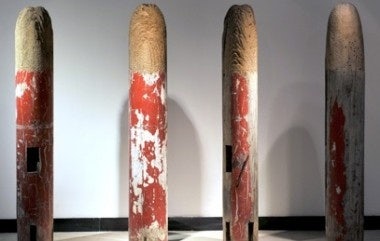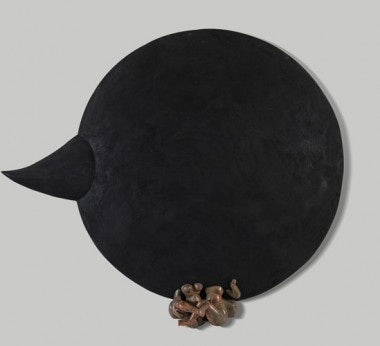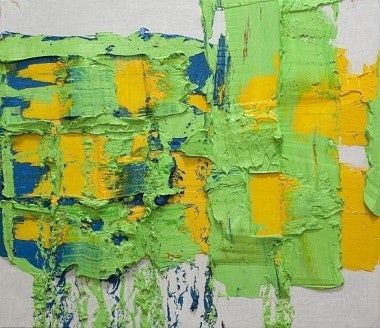"Window In The Wall" Exhibition, Curated By Gayatri Sinha And Gao Minglu, Running At Pearl Lam Fine Art Through November 9#

Earlier this month, Jing Daily caught up with the inimitable gallerist Pearl Lam in Shanghai for a chat on the sidelines of SH Contemporary, the Asia-Pacific Contemporary Art Fair. Covering everything from the "Window in the Wall" exhibition running at Pearl Lam Fine Art through November 9 to her role in changing international pre-conceptions of Chinese contemporary art, our talk shed light on many of the issues currently facing the Shanghai (and, more broadly, Chinese) art world: censorship, infrastructure, and competition from Hong Kong, to name a few.
Jing Daily (JD): Could you tell us a little about "Window in the Wall"?#
Pearl Lam (PL)#
: The newest news? 50% of the work is in customs, and they won't release it. This is the India-China relationship - not very smooth. Last year there was another exhibition about Indian and Chinese art, and the organizers actually had to delay the opening date 10 days, because the artwork was stuck in customs. So the curator and the artists are all here from India, but the works are stuck in customs. That's the newest news.
This exhibition is curated by Guyatri Sinha and Gao Minglu. The goal is to explore, China and India are among the world's oldest civilizations. Both countries have gone through huge changes and political upheaval, and even though China is labeled as Communist, actually China is as capitalistic as India, and there is a lot of urbanization. So what is the impact of that, relating urbanization with old cultures? Both curators have been addressing these issues within this exhibition. But unfortunately, you won't see most of that [when it opens] tomorrow.
JD: It sounds like a metaphor for India-China relations.#
PL#
: It's absolutely a metaphor. Just now, I had lunch with an Indian artist and curator, and I asked them, why isn't there ever a really large Indian exhibition in China, or a large Chinese exhibition in India? And they said to me, "that is the India-China relationship." They said Indians are very intimidated by China -- it's the only country they're intimidated by -- but when they actually come into China they feel that we are so much more similar, in terms of our traditions, culture, our Buddhist theory. Because Buddhism's actually from India, and Buddhism is one of the things that defined our Chinese culture. So it's very interesting.

JD: Can you give a quick run-down of some of the artists you've chosen to show at SH Contemporary?#
PL#
: We were supposed to have two works from the Indian show, so that's now changed. The general curatorial direction of the gallery has always been focusing on Chinese contemporary art that evolved from tradition, in contradiction to the Western conception that contemporary art here is cut off from tradition. We've always said we can't cut Chinese contemporary art from tradition. We’re a very old culture, we're an old civilization that hasn't ended, we didn't have a dark age. Also, looking at Chinese history and the dynamics of the 20th century, Western contemporary art is all derived from the West and, more specifically, from art in the 20th century and the development of psychology and sociology theory. We didn't have that. So our evolution just started with Mao’s death in 1976. We've been looking at what we have and looking at our culture. As a gallery, we're looking at [Chinese] artists who have all derived from tradition but have been impacted by Western influence and the Western approach to art.
JD: You stopped showing at SH Contemporary for a couple of years, what can you say about how the event has changed over the years?#
PL#
: This year it got a new director and we were asked to support it so we came back, but we were the last gallery to join. So we'll have to see. Because everyone knows now that Hong Kong is the leading art fair, and Hong Kong has an infrastructure where there's no censorship and no customs problems. Here there are obvious customs problems, so we'll have to see what Shanghai will turn out to be. Because if Shanghai will relax these problems, censorship and customs, it can compete with Hong Kong.
JD: How do you feel about the role of domestic and local collectors in the Chinese art world? Are you seeing more sophistication among them when they come into your gallery?#
PL#
: Art collectors, definitely. There are some really coy collectors who are very interesting -- they are curious, they actually care about the curatorial side and make friends with curators. They develop just like [they did] in the West. Then there are the speculators who follow the auction market. And of course they behave differently. Then there are the newcomers who like to buy labels. If you want to see why artists like Zeng Fanzhi and Zhang Xiaogang attract such high prices, you just have to look at Chinese consumer behavior: they love labels. It’s sort of a lack of confidence. They love Louis Vuitton, they love Christian Dior, and for them to buy a "label" artist is also part of their fear of taking a risk. They don't want to make a mistake. Internationally it's the same phenomenon - you don't want to make a mistake.
JD: Do you feel that fairs like SH Contemporary play a role in educating collectors, or is it the job of the individual curators, gallerists and museums to educate?#
PL#
: These shows will not educate them, and even the museum shows won't be able to. Most of these really coy people actually go abroad to see shows. But what's important is the development of private museums and art advisory [services]. But art advisory is different here than it is in the West. Here it's just like friends sitting together talking about art, it's more like a salon. An art fair is an art fair. It’s difficult for an art fair to offer a new experience.

JD: So who is one Chinese artist you think the world really should know about?#
PL#
: Zhu Jinshi. The way he applies paint so thickly, and some of his large paintings take up to three years to make. He’s an original member of the Stars group who moved to Germany in 1989 or 1990. He was a factory worker there and eventually got an art scholarship. He started off doing installation, and by 2000 he started looking at calligraphy. In China we've always considered Western abstract art to be kind of like Chinese calligraphy, so there's a lot that looks abstract in Western eyes but is derived from calligraphy. Zhu Jinshi's work is all concerned with questioning emotions, life, and philosophy in a Chinese way.
What I want to address in that when there are Chinese paintings like this, people in the West always say they're derivative, but China had representational art in 700 AD. We were pouring ink on paper centuries before Jackson Pollock. So the West has to also realize that we're not saying work by Jackson Pollock or anybody is derivative, because their approach and philosophy is so different. So the work is meant to challenge Western arrogance on what they think they know but don't know.
JD: So trying in a way to show the universality of art around the world, or closing the circle?#
PL#
: It's closing the circle. So, opening the Western world up -- there is another way of looking at art. There’s another approach of looking at art. It's not about Western dominance, because that's just like colonialism. In the 1950s, plenty of Western artists were looking at Chinese philosophy. Why is it all of a sudden people suddenly act like it's a new thing?
I think what art brings us is a bigger world. And what I love about art is that I’m learning from people. So hopefully people won't come to us and say, "You're making derivative art!"
Window in the Wall: India and China - Imaginary Conversations#
September 9 - November 9, 2011
Pearl Lam Galleries
No. 181 Middle Jiangxi Road
Shanghai, China
Event Website